Bryan L. Programmable controllers. Theory and implementation
Подождите немного. Документ загружается.

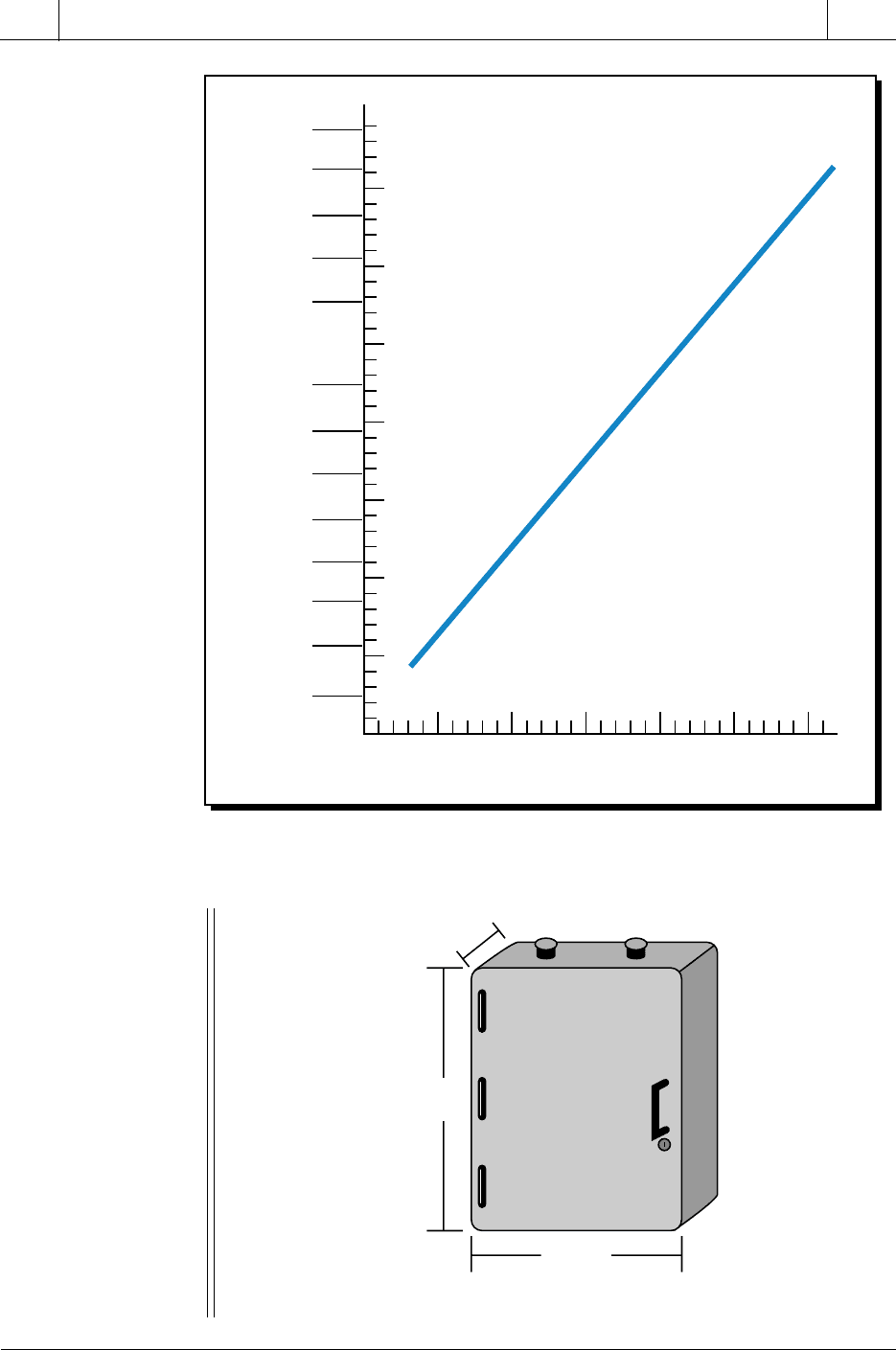
939
CHAPTER
20
PLC Start-Up
and Maintenance
SECTION
6
Installation
and Start-Up
Industrial Text & Video Company 1-800-752-8398
www.industrialtext.com
Figure 20-14. Temperature rise graph for a NEMA 12 enclosure.
Figure 20-15. NEMA 12 enclosure.
Courtesy of Hoffman Engineering Co., Anoka, MN
Height
72 inches
Depth
36 inches
Width
48 inches
5 1015202530
Temperature rise (∆
T
) above room temperature
10°C
20°C
30°C
40°C
50°C
60°C
70°C
10°F
20°F
30°F
40°F
50°F
60°F
70°F
80°F
90°F
100°F
110°F
120°F
130°F
140°F
Input Power (watts per sq. ft.)

940
SECTION
6
Installation
and Start-Up
Industrial Text & Video Company 1-800-752-8398
www.industrialtext.com
CHAPTER
20
PLC Start-Up
and Maintenance
SOLUTION
(a) To calculate the temperature rise, first calculate the total area
(square feet) of the exposed sides of the enclosure. Assuming that the
back and bottom sides of the enclosure are not exposed, the area of
each exposed side equals:
Front area= (Height)(Width)
= (6 ft)(4 ft)
= 24 ft
Side area= (Height)(Depth)
= (6 ft)(3 ft)
= 18 ft
Top area= (Depth)(Width)
= (3 ft)(4 ft)
= 12 ft
2
2
2
Therefore, the total area for heat dissipation, taking into account that
there are two sides, is:
Total area= 24 ft ft ft
72 ft
222
2
++
=
218 12()
So, 1011 watts of total power in the enclosure is distributed over a
total surface area of 72 ft
2
, resulting in a power dissipation per square
foot of 14.04 watts:
Power dissipation=
1011 watts
ft
watts/ft
2
2
72
14 04= .
From the temperature rise curve for a NEMA 12 enclosure, we can find
that the temperature rise is approximately 32°C or 57.5°F. Therefore,
this system will experience a final temperature (ambient + rise) of
approximately 64.2°C (32.2°C + 32°C) or 147.5°F (90°F + 57.5°F).
This temperature exceeds the PLC’s maximum operating temperature
of 60°C, meaning that a malfunction could occur because of the high
temperature inside the enclosure. This system, therefore, requires
proper ventilation or cooling.
(b) The required airflow inside the enclosure is based on the maximum
operating temperature of the components (e.g., 60°C for a PLC).

941
CHAPTER
20
PLC Start-Up
and Maintenance
SECTION
6
Installation
and Start-Up
Industrial Text & Video Company 1-800-752-8398
www.industrialtext.com
Assuming that all inside components can withstand up to 60°C
(140°F), the permissible temperature rise (∆
T
) in °F of the cooling air
is:
∆
T
=−
°°
°
Max temp of enclosure Max temp of components
=179.6 F –140 F
=39.6 F
The required airflow
Q
air
is given by the equation:
Q
T
air
KW of enclosure
=
()( )3160
∆
where the term 3160 is a constant, KW is the kilowatt heat of the
enclosure (in this case 1.011 KW) and ∆
T
is the permissible tempera-
ture. Therefore, the airflow requirement is:
Q
air
3
ft /min
=
=
()(.)
.
.
3160 1 011
39 6
80 68
Thus, a minimum airflow of 80.68 ft
3
/min is required to dissipate the
heat in the enclosure.
Excessive Line Voltage Variation. The power supply section of a PLC
system can sustain line fluctuations and still allow the system to function
within its operating margin. As long as the incoming voltage is adequate, the
power supply provides all the logic voltages necessary to support the
processor, memory, and I/O. However, if the voltage drops below the
minimum acceptable level, the power supply will alert the processor, which
will then execute a system shutdown.
In applications that are subject to “soft” AC lines and unusual line variations,
the first step towards a solution is to correct any possible feeder problem
in the distribution system. If this correction does not solve the problem, then
a constant voltage transformer can be used to prevent the system from
shutting down too often (see Figure 20-16). The constant voltage transformer
stabilizes the input voltage to the power supply and input field devices by
compensating for voltage changes at the primary to maintain a steady voltage
in the secondary. When using a constant voltage transformer, the user should
check that its power rating is sufficient to supply the input devices and the
power supply. Also, the user should connect the output devices in front of the
constant voltage transformer, rather than behind it, so that the transformer is
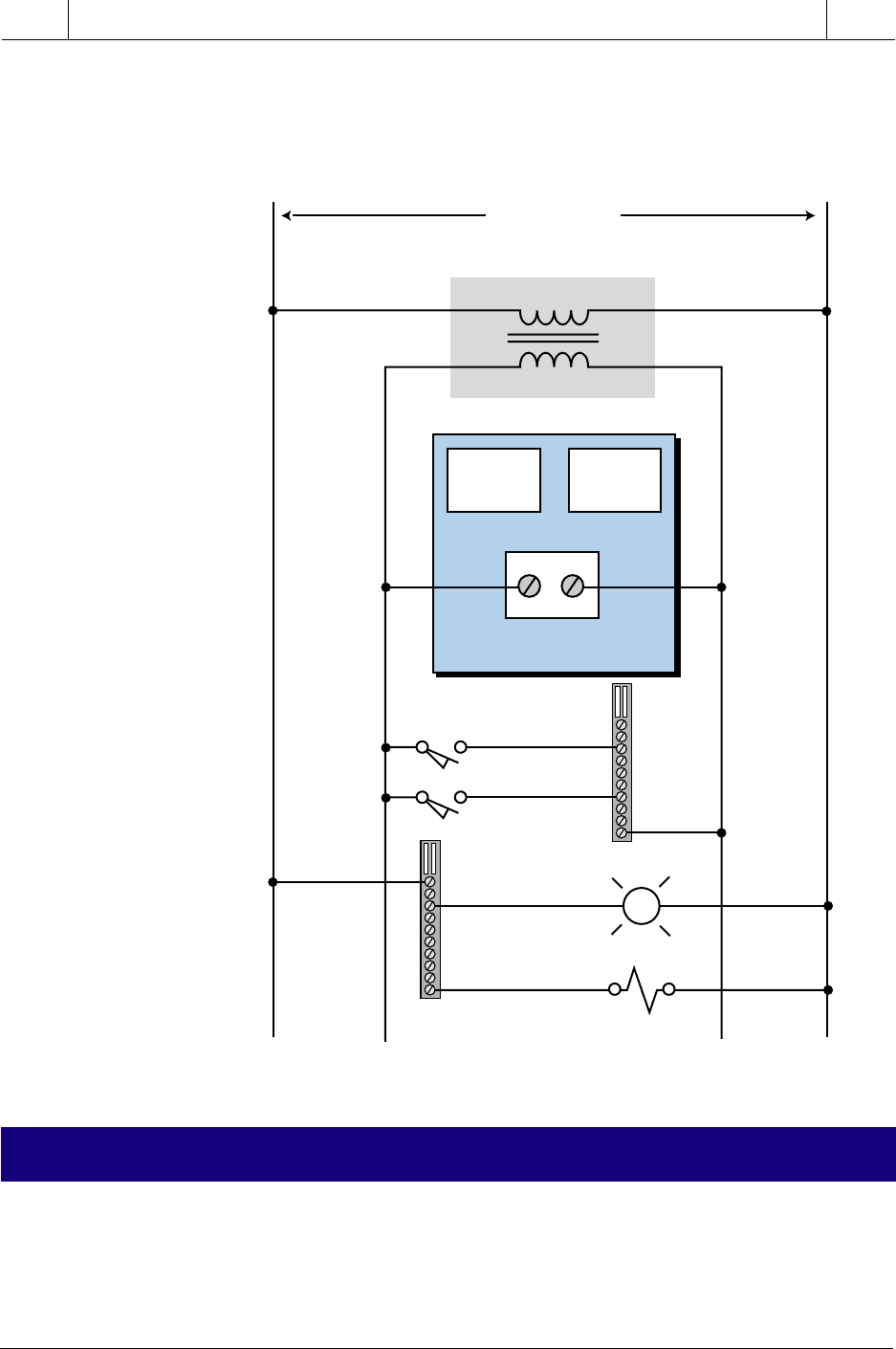
942
SECTION
6
Installation
and Start-Up
Industrial Text & Video Company 1-800-752-8398
www.industrialtext.com
CHAPTER
20
PLC Start-Up
and Maintenance
not providing power to the outputs. This arrangement will lessen the load
supported by the transformer, allowing a smaller transformer to be used. The
manufacturer can provide information regarding power rating requirements.
Figure 20-16. Constant voltage transformer used to stabilize input voltage.
20-4 I/O INSTALLATION, WIRING, AND PRECAUTIONS
Input/output installation is perhaps the biggest and most critical job when
installing a programmable controller system. To minimize errors and sim-
plify installation, the user should follow predefined guidelines. All of the
people involved in installing the controller should receive these I/O system
Primary
Constant Voltage
Transformer
Secondary
CPU
Processor Memory
Power
Supply
AC Input
Module
AC Output
Module
To AC Source
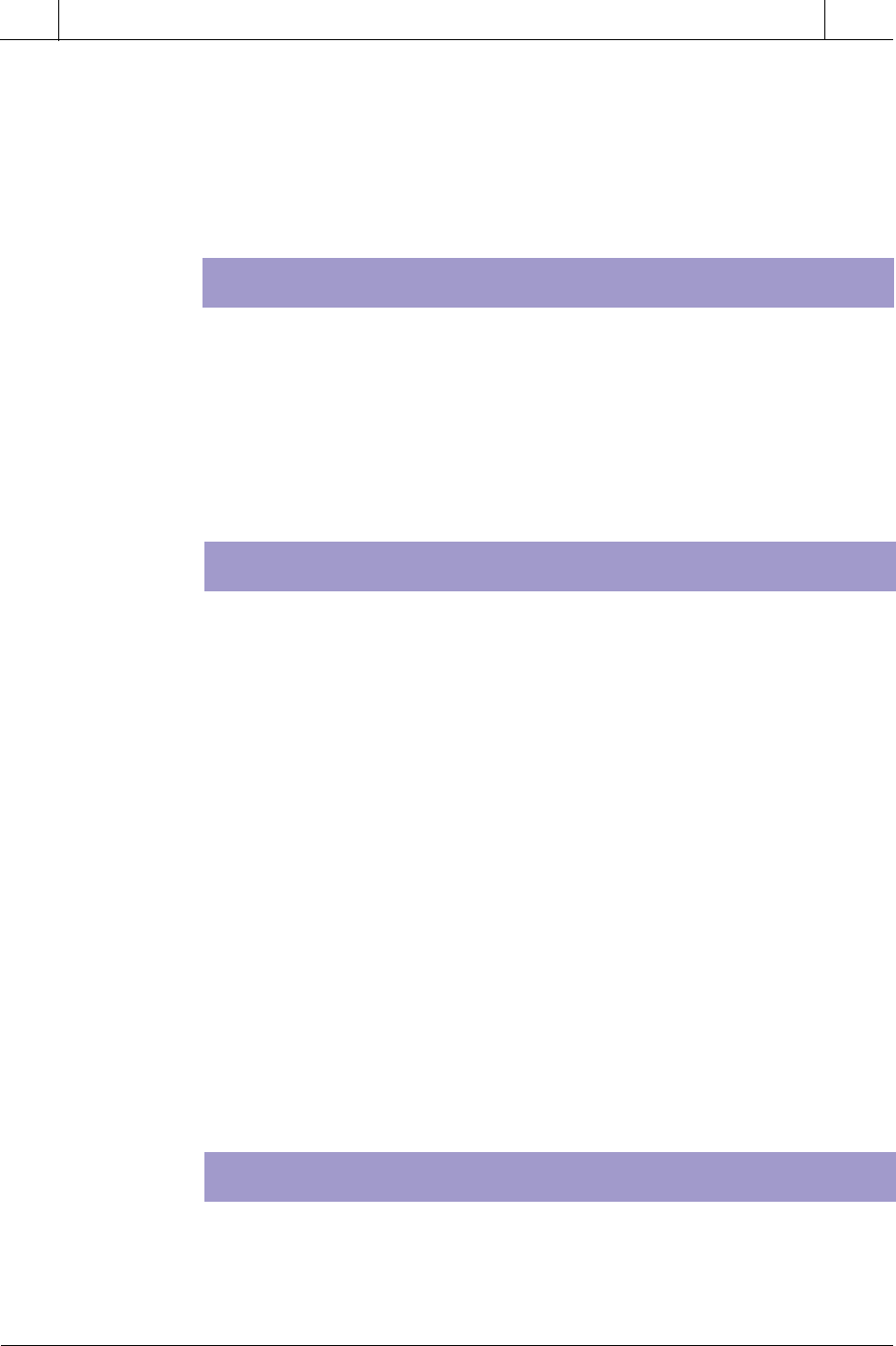
943
CHAPTER
20
PLC Start-Up
and Maintenance
SECTION
6
Installation
and Start-Up
Industrial Text & Video Company 1-800-752-8398
www.industrialtext.com
I/O MODULE INSTALLATION
Placement and installation of the I/O modules is simply a matter of inserting
the correct modules in their proper locations. This procedure involves
verifying the type of module (115 VAC output, 115 VDC input, etc.) and the
slot address as defined by the I/O address assignment document. Each
terminal in the module is then wired to the field devices that have been
assigned to that termination address. The user should remove power to the
modules (or rack) before installing and wiring any module.
installation guidelines, which should have been prepared during the design
phase. A complete set of documents with precise information regarding I/O
placement and connections will ensure that the system is organized properly.
Furthermore, these documents should be constantly updated during every
stage of the installation. The following considerations will facilitate an
orderly installation.
WIRING CONSIDERATIONS
Wire Size. Each I/O terminal can accept one or more conductors of a
particular wire size. The user should check that the wire is the correct gauge
and that it is the proper size to handle the maximum possible current.
Wire and Terminal Labeling. Each field wire and its termination point
should be labeled using a reliable labeling method. Wires should be labeled
with shrink-tubing or tape, while tape or stick-on labels should identify each
terminal block. Color coding of similar signal characteristics (e.g., AC: red,
DC: blue, common: white, etc.) can be used in addition to wire labeling.
Typical labeling nomenclature includes wire numbers, device names or
numbers, and the input or output address assignment. Good wire and terminal
identification simplifies maintenance and troubleshooting.
Wire Bundling. Wire bundling is a technique commonly used to simplify
the connections to each I/O module. In this method, the wires that will be
connected to a single module are bundled, generally using a tie wrap, and then
routed through the duct with other bundles of wire with the same signal
characteristics. Input, power, and output bundles carrying the same type of
signals should be kept in separate ducts, when possible, to avoid interference.
WIRING PROCEDURES
Once the I/O modules are in place and their wires have been bundled, the
wiring to the modules can begin. The following are recommended procedures
for I/O wiring:

944
SECTION
6
Installation
and Start-Up
Industrial Text & Video Company 1-800-752-8398
www.industrialtext.com
CHAPTER
20
PLC Start-Up
and Maintenance
• Remove and lock out input power from the controller and I/O before
any installation and wiring begins.
• Verify that all modules are in the correct slots. Check module type
and model number by inspection and on the I/O wiring diagram.
Check the slot location according to the I/O address assignment
document.
• Loosen all terminal screws on each I/O module.
• Locate the wire bundle corresponding to each module and route it
through the duct to the module location. Identify each of the wires in
the bundle and check that they correspond to that particular module.
• Starting with the first module, locate the wire in the bundle that
connects to the lowest terminal. At the point where the wire is at a
vertical height equal to the termination point, bend the wire at a right
angle towards the terminal.
• Cut the wire to a length that extends 1/4 inch past the edge of the
terminal screw. Strip approximately 3/8 inch of insulation from the
end of the wire. Insert the uninsulated end of the wire under the
pressure plate of the terminal and tighten the screw.
• If two or more modules share the same power source, jumper the
power wiring from one module to the next.
• If shielded cable is being used, connect only one end to ground,
preferably at the rack chassis. This connection will avoid possible
ground loops. A ground loop condition exists when two or more
electrical paths are created in a ground line or when one or more paths
are created in a shield (Section 20-7 explains how to identify a ground
loop). Leave the other end cut back and unconnected, unless other-
wise specified.
• Repeat the wiring procedure for each wire in the bundle until the
module wiring is complete.
• After all of the wires are terminated, check for good terminations by
gently pulling on each wire.
SPECIAL I/O CONNECTION PRECAUTIONS
Chapters 6, 7, and 8 presented typical connection diagrams for the various
types of I/O modules. Certain field device wiring connections, however, may
need special attention. These connections include leaky inputs, inductive
loads, output fusing, and shielded cable.
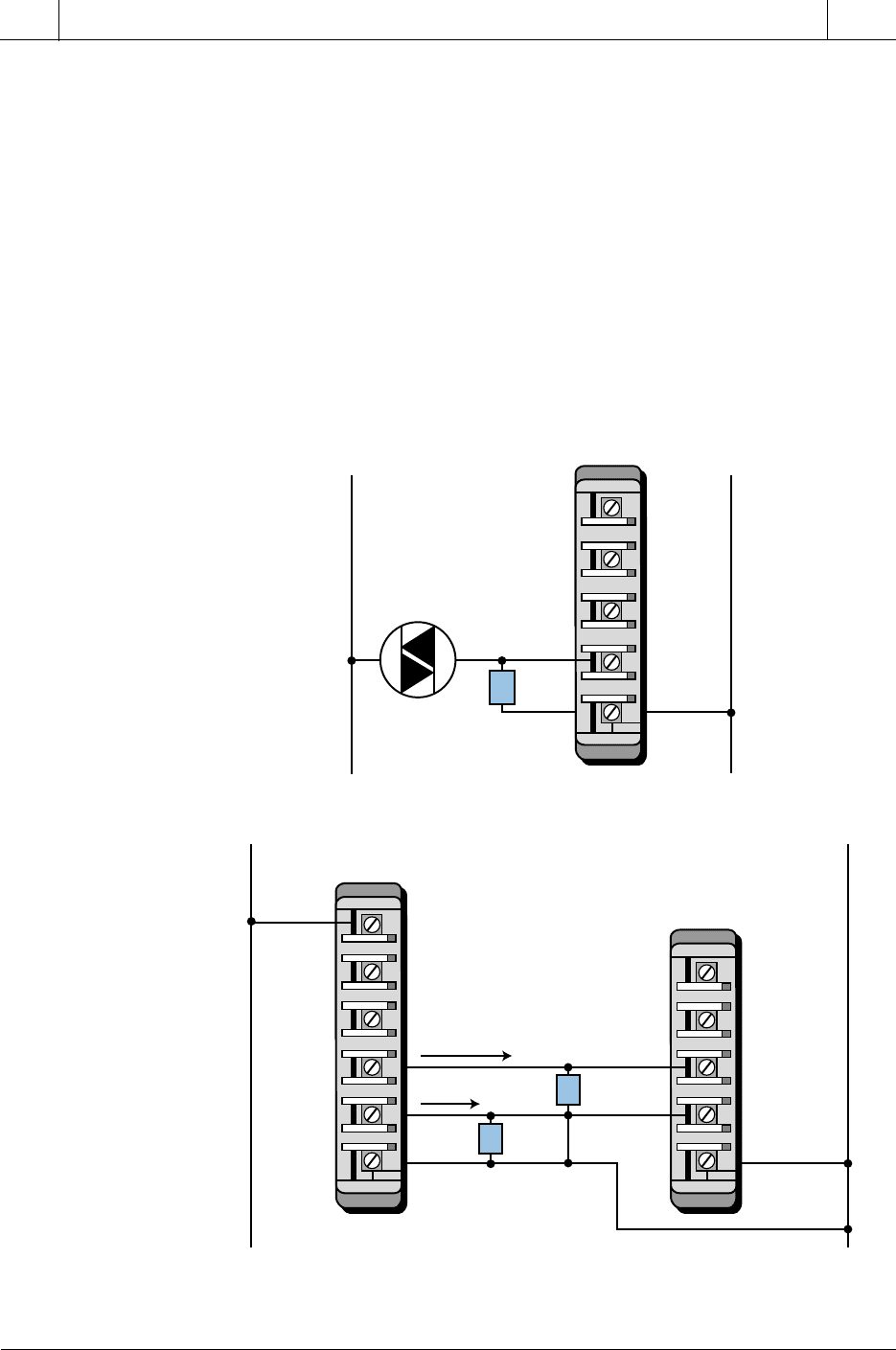
945
CHAPTER
20
PLC Start-Up
and Maintenance
SECTION
6
Installation
and Start-Up
Industrial Text & Video Company 1-800-752-8398
www.industrialtext.com
Connecting Leaky Inputs. Some field devices have a small leakage current
even when they are in the OFF state. Both triac and transistor outputs exhibit
this leakage characteristic, although transistor leakage current is much lower.
Most of the time, the leaky input will only cause the module’s input indicator
to flicker; but sometimes, the leakage can falsely trigger an input circuit,
resulting in misoperation. A typical device that exhibits this leakage situation
is a proximity switch. This type of leakage may also occur when an output
module drives an input module when there is no other load.
Figure 20-17 illustrates two leakage situations, along with their corrective
actions. A leaky input can be corrected by placing a bleeding (or loading)
resistor across the input. A bleeding resistor introduces resistance into the
circuit, causing the voltage to drop on the line between the leaky field device
Figure 20-17. (a) A connection for a leaky input device and (b) the connection of an
output module to an input module.
R
R
L1 L2
2
3
4
C
1
R
Device’s
Output Triac
(a)
L1 L2
2
3
4
C
1
(b)
120 VAC
Input
2
3
4
C
1
L1
120 VAC
Output
Leakage
current
i
L
i
L
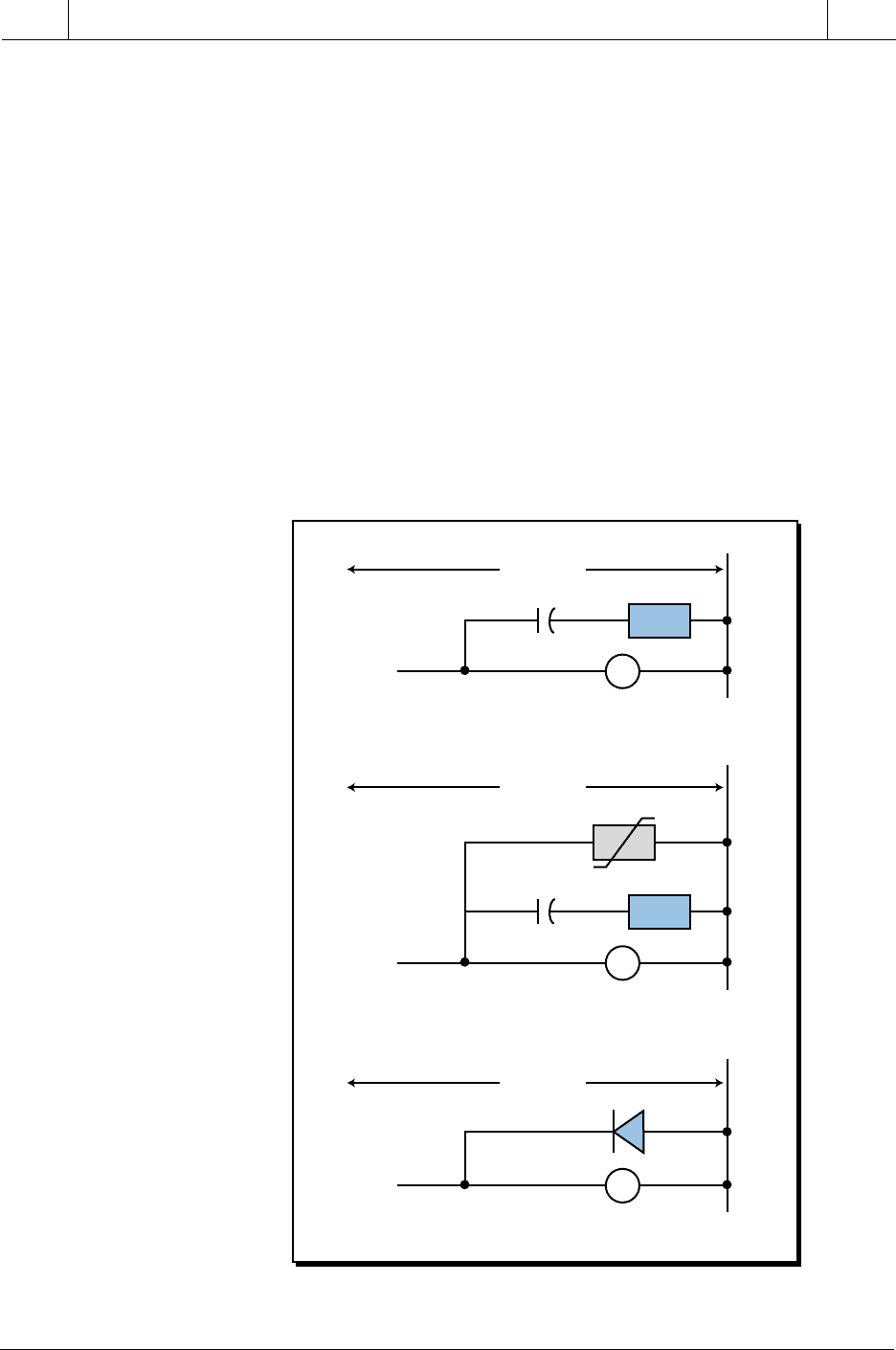
946
SECTION
6
Installation
and Start-Up
Industrial Text & Video Company 1-800-752-8398
www.industrialtext.com
CHAPTER
20
PLC Start-Up
and Maintenance
and the input circuit. This causes a shunt on the input’s terminals. Conse-
quently, the leakage current is routed through the bleeding resistor, minimiz-
ing the amount of current to the input module (or to the output device). This
prevents the input or output from turning ON when it should be OFF.
Suppression of Inductive Loads. The interruption of current caused by
turning an inductive load’s output OFF generates a very high voltage spike.
These spikes, which can reach several thousands of volts if not suppressed,
can occur either across the leads that feed power to the device or between both
power leads and the chassis ground, depending on the physical construction
of the device. This high voltage causes erratic operation and, in some cases,
may damage the output module. To avoid this situation, a snubber circuit,
typically a resistor/capacitor network (RC) or metal oxide varistor (MOV),
should be installed to limit the voltage spike, as well as control the rate of
current change through the inductor (see Figure 20-18).
Figure 20-18. (a) Small, (b) large, and (c) DC load suppression techniques.
CR
120 VAC
(a) Small load suppression (AC)
CR
MOV
120 VAC
(b) Large load suppression (AC)
120 VDC
(c) DC load suppression
D
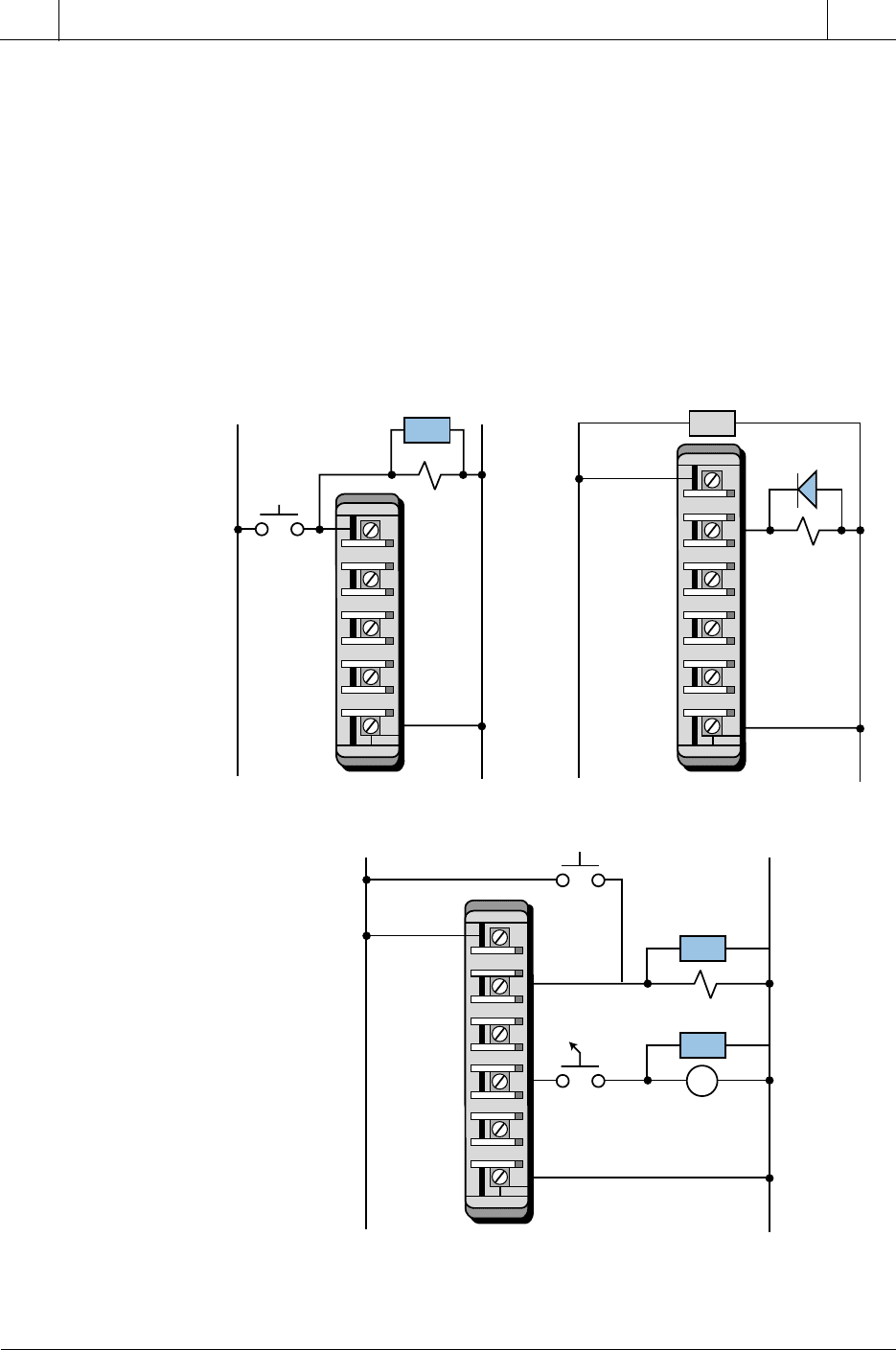
947
CHAPTER
20
PLC Start-Up
and Maintenance
SECTION
6
Installation
and Start-Up
Industrial Text & Video Company 1-800-752-8398
www.industrialtext.com
Most output modules are designed to drive inductive loads, so they typically
include suppression networks. Nevertheless, under certain loading condi-
tions, the triac may be unable to turn OFF as current passes through zero
(commutation), thus requiring additional external suppression in the system.
An RC snubber circuit placed across the device can provide additional
suppression for small AC devices, such as solenoids, relays, and motor
starters up to size 1. Larger contactors (size 2 and above) require an MOV in
addition to the RC network. A free-wheeling diode placed across the load can
provide DC suppression. Figure 20-19 presents several examples of inductive
load suppression.
Figure 20-19. Suppression of (a) a load in parallel with a PLC input module, (b) a DC load,
and (c) loads with switches in parallel and series with a PLC output module.
AC Suppressor
L1 L2
2
3
4
C
1
(a)
2
3
4
–V
1
+V
2
3
4
–V
1
+V
AC Suppressor
L1 L2
(c)
AC Suppressor
(b)
Diode
Suppressor
+–
User DC Supply
M
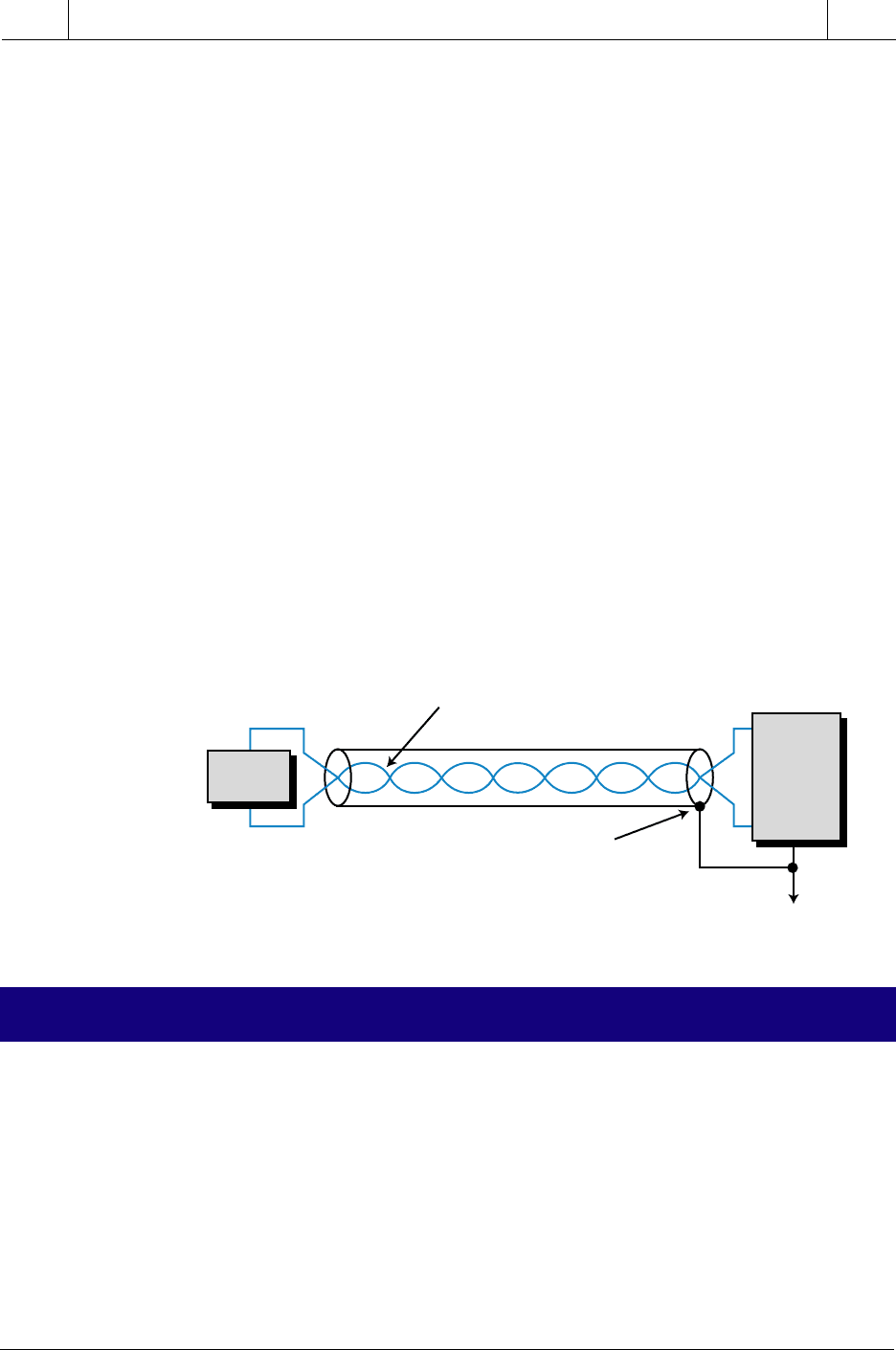
948
SECTION
6
Installation
and Start-Up
Industrial Text & Video Company 1-800-752-8398
www.industrialtext.com
CHAPTER
20
PLC Start-Up
and Maintenance
Fusing Outputs. Solid-state outputs normally have fusing on the module, to
protect the triac or transistor from moderate overloads. If the output does not
have internal fuses, then fuses should be installed externally (normally at the
terminal block) during the initial installation. When adding fuses to an output
circuit, the user should adhere to the manufacturer’s specifications for the
particular module. Only a properly rated fuse will ensure that the fuse will
open quickly in an overload condition to avoid overheating of the output
switching device.
Shielding. Control lines, such as TTL, analog, thermocouple, and other low-
level signals, are normally routed in a separate wireway, to reduce the effects
of signal coupling. For further protection, shielded cable should be used for
the control lines, to protect the low-level signals from electrostatic and
magnetic coupling with both lines carrying 60 Hz power and other lines
carrying rapidly changing currents. The twisted, shielded cable should have
at least a one-inch lay, or approximately twelve twists per foot, and should be
protected on both ends by shrink-tubing or a similar material. The shield
should be connected to control ground at only one point (see Figure 20-20),
and shield continuity must be maintained for the entire length of the cable. The
shielded cable should also be routed away from high noise areas, as well as
insulated over its entire length.
20-5 PLC START-UP AND CHECKING PROCEDURES
Prior to applying power to the system, the user should make several final
inspections of the hardware components and interconnections. These in-
spections will undoubtedly require extra time. However, this invested time
will almost always reduce total start-up time, especially for large systems
with many input/output devices. The following checklist pertains to prestart-
up procedures:
• Visually inspect the system to ensure that all PLC hardware compo-
nents are present. Verify correct model numbers for each component.
Figure 20-20. Shielded cable ground connection.
Shielded Twisted-Pair Wire
Sensing
Device
PC
Interface
To Control
Ground
Shield connected
to ground at only
one point
